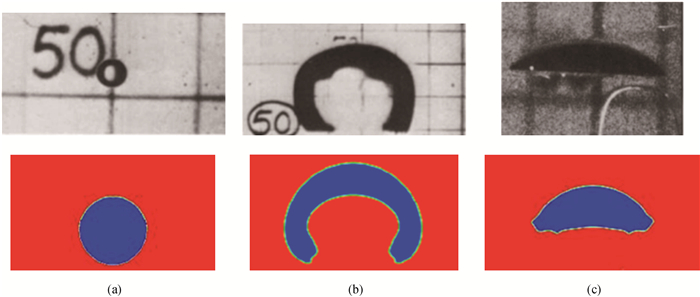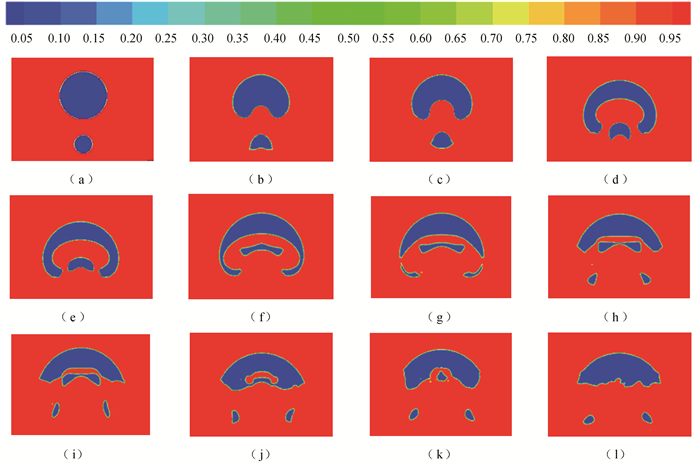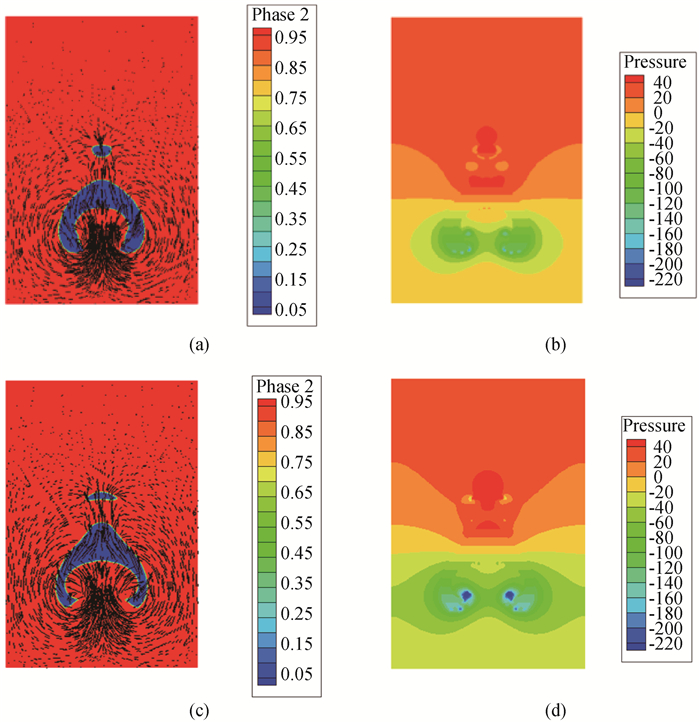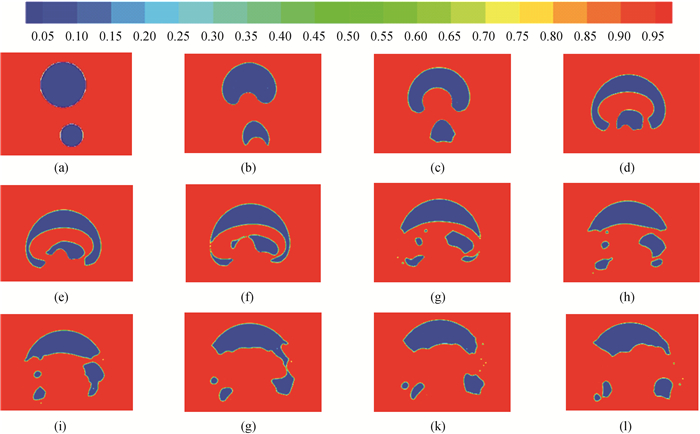计算物理 ›› 2022, Vol. 39 ›› Issue (1): 41-52.DOI: 10.19596/j.cnki.1001-246x.8363
收稿日期:2021-03-23
出版日期:2022-01-25
发布日期:2022-09-03
通讯作者:
张华
作者简介:赵腾飞(1995-),男,博士研究生,E-mail: 2318604995@qq.com
基金资助:
Tengfei ZHAO( ), Hua ZHANG*(
), Hua ZHANG*( )
)
Received:2021-03-23
Online:2022-01-25
Published:2022-09-03
Contact:
Hua ZHANG
摘要:
以水气两相流为研究对象, 采用大涡模拟和流体体积法, 结合破碎准则和第三代涡识别方法对双气泡碰撞过程进行数值模拟。采用单一变量法, 研究气泡直径比、相对偏心距及气泡间相对距离对气泡破碎程度的影响。双气泡碰撞过程中, 两气泡的直径越接近时, 碰撞过程中的气泡破碎程度越弱, 偏心距的变化对气泡破碎程度影响不大。而相对距离小于1时, 随着其增大, 气泡碰撞过程中的破碎程度更加明显。当气泡相对距离大于1时, 气泡破碎程度趋于平缓。研究表明: 第三代涡识别方法能够很好地捕捉两相流湍流流场中漩涡位置, 并能敏锐地反映出湍流的变化。
赵腾飞, 张华. 气泡碰撞过程中形变及破碎现象分析[J]. 计算物理, 2022, 39(1): 41-52.
Tengfei ZHAO, Hua ZHANG. Analysis of Deformation and Breakage During Bubble Collision[J]. Chinese Journal of Computational Physics, 2022, 39(1): 41-52.

图4 不同时刻静止液体中单个气泡上升运动形态对比(上图为实验图像,下图为模拟图像。) (a) t=0.01 s; (b) t=0.1 s; (c) t=0.22 s
Fig.4 Contrast of single bubble ascending motion in still liquid at different moments(The upper row are images of experiment; The lower row are images of simulation.) (a) t=0.01 s; (b) t=0.1 s; (c) t=0.22 s
| 算例序号 | 先导气泡直径/mm | 尾随气泡直径/mm | 直径比 | 相对距离ξz |
| 1 | 2 | 8 | 0.25 | 0.75 |
| 2 | 4 | 8 | 0.5 | 0.75 |
| 3 | 6 | 8 | 0.75 | 0.75 |
| 4 | 8 | 8 | 1 | 0.75 |
| 5 | 8 | 6.4 | 1.25 | 0.75 |
| 6 | 8 | 5.3 | 1.5 | 0.75 |
| 7 | 8 | 4.57 | 1.75 | 0.75 |
| 8 | 8 | 4 | 2 | 0.75 |
| 9 | 8 | 3 | 2.67 | 0.75 |
| 10 | 8 | 3 | 2 | 0.25, 0.5, 0.75, 1 |
表1 正心碰撞算例
Table 1 Positive center collision calculation examples
| 算例序号 | 先导气泡直径/mm | 尾随气泡直径/mm | 直径比 | 相对距离ξz |
| 1 | 2 | 8 | 0.25 | 0.75 |
| 2 | 4 | 8 | 0.5 | 0.75 |
| 3 | 6 | 8 | 0.75 | 0.75 |
| 4 | 8 | 8 | 1 | 0.75 |
| 5 | 8 | 6.4 | 1.25 | 0.75 |
| 6 | 8 | 5.3 | 1.5 | 0.75 |
| 7 | 8 | 4.57 | 1.75 | 0.75 |
| 8 | 8 | 4 | 2 | 0.75 |
| 9 | 8 | 3 | 2.67 | 0.75 |
| 10 | 8 | 3 | 2 | 0.25, 0.5, 0.75, 1 |

图5 正心碰撞双气泡上升过程形态演变(a) t=0 s; (b) t=0.04 s; (c) t=0.05 s; (d) t=0.08 s; (e) t=0.09 s; (f) t=0.11 s; (g) t=0.12 s; (h) t=0.14 s; (i) t=0.15 s; (j) t=0.16 s; (k) t=0.17 s; (l) t=0.19 s
Fig.5 Shape evolution in rising process of positive center collision of two bubbles (a) t=0 s; (b) t=0.04 s; (c) t=0.05 s; (d) t=0.08 s; (e) t=0.09 s; (f) t=0.11 s; (g) t=0.12 s; (h) t=0.14s; (i) t=0.15 s; (j) t=0.16 s; (k) t=0.17 s; (l) t=0.19 s

图6 正心碰撞0.11 s气泡运动要素(a)气相及流速矢量; (b)压强及流速矢量; (c)Liutex向量及流速矢量
Fig.6 Bubble motion in positive center collision at 0.11 second (a) gas phase and velocity vectors; (b) pressure and velocity vectors; (c) Liutex vector and velocity vectors

图11 气泡上升过程速度矢量及压强云图(a) 0.09 s时速度矢量图; (b) 0.09 s时压强云图; (c) 0.11 s时速度矢量图; (d) 0.11 s时压强云图
Fig.11 Velocity vectors and pressure cloud maps during bubble rising (a) velocity vectors at 0.09 s; (b) pressures at 0.09 s; (c) velocity vectos at 0.11 s; (d) pressures at 0.11 s

图13 偏心碰撞双气泡上升过程形态演变(a) t=0 s; (b) t=0.04 s; (c) t=0.06 s; (d) t=0.09 s; (e) t=0.1 s; (f) t=0.11s; (g) t=0.12 s; (h) t=0.13 s; (i) t=0.14 s; (g) t=0.16 s; (k) t=0.17 s; (l) t=0.19 s
Fig.13 Shape evolution in rising process of eccentric collision of two bubbles (a) t=0 s; (b) t=0.04 s; (c) t=0.06 s; (d) t=0.09 s; (e) t=0.1 s; (f) t=0.11 s; (g) t=0.12 s; (h) t=0.13 s; (i) t=0.14 s; (g) t=0.16 s; (k) t=0.17 s; (l) t=0.19 s

图14 偏心碰撞0.1 s气泡运动要素(a)气相及流速矢量; (b)压强及流速矢量; (c) Liutex向量及流速矢量
Fig.14 Bubble motion in eccentric collision at 0.1 second (a) gasous phase and velocity vectors; (b) pressure and velocity vectors; (c) Liutex vectors and velocity vectors
| 1 |
DOI |
| 2 |
|
| 3 |
DOI |
| 4 |
DOI |
| 5 |
|
| 6 |
|
| 7 |
|
| 8 |
|
| 9 |
张阿漫, 王诗平, 白兆宏, 等. 不同环境下气泡脉动特性实验研究[J]. 力学学报, 2011, 43 (1): 71- 83.
|
| 10 |
张阿漫, 姚熊亮, 李佳. 气泡群的动态物理特性研究[J]. 物理学报, 2008, 57 (3): 1672- 1682.
|
| 11 |
|
| 12 |
|
| 13 |
|
| 14 |
戚定满, 鲁传敬, 何友声. 两空泡运动特性研究[J]. 力学季刊, 2000, 21 (1): 16- 20.
|
| 15 |
|
| 16 |
DOI |
| 17 |
闻昭权. 气泡聚并机理的实验及模型研究[D]. 湘潭: 湘潭大学, 2019.
|
| 18 |
严鹏. 鼓泡塔内气液流动行为的CFD-PBM耦合模型数值模拟[D]. 北京: 北京石油化工学院, 2019.
|
| 19 |
|
| 20 |
李帅, 孙龙泉, 张阿漫. 水中上浮气泡动态特性研究[J]. 物理学报, 2014, 63 (18): 291- 303.
|
| 21 |
孙姣, 姜楠, 陈文义, 等. 静止水中单个近壁大气泡运动特性的实验研究[J]. 实验力学, 2019, 34 (6): 973- 980.
|
| 22 |
李文强, 焦守华, 唐珂, 等. 静水中单气泡运动特性实验研究[J]. 原子能科学技术, 2020, 54 (9): 1652- 1659.
|
| 23 |
DOI |
| 24 |
DOI |
| 25 |
DOI |
| 26 |
|
| 27 |
DOI |
| 28 |
|
| 29 |
DOI |
| 30 |
DOI |
| 31 |
DOI |
| 32 |
|
| 33 |
黄程蓉, 陈小鹏, 周丹, 等. 黏性溶液中单个气泡的运动形变[J]. 高校化学工程学报, 2018, 32 (5): 1012- 1028.
|
| 34 |
|
| 35 |
蒋炎坤, 褚开星. 基于VOF方法发动机水下排气气泡特性研究[J]. 华中科技大学学报(自然科学版), 2015, 43 (10): 10- 14.
|
| [1] | 刘利, 牛胜利, 朱金辉, 左应红, 谢红刚, 商鹏. 临近空间核爆炸碎片云运动的数值模拟[J]. 计算物理, 2022, 39(5): 521-528. |
| [2] | 张浏斌, 单彦广, 戎志成. 基于LBM的均匀电场池沸腾单气泡动力学模拟[J]. 计算物理, 2022, 39(5): 537-548. |
| [3] | 吴丽媛, 张素英. 自旋相关光晶格中玻色-爱因斯坦凝聚体的基态[J]. 计算物理, 2022, 39(5): 617-623. |
| [4] | 杜旭林, 程林松, 牛烺昱, 陈玉明, 曹仁义, 谢永红. 考虑水力压裂缝和天然裂缝动态闭合的三维离散缝网数值模拟[J]. 计算物理, 2022, 39(4): 453-464. |
| [5] | 孙梦营, 马明, 过海龙, 姚孟君, 徐猛, 张莹. 零重力点热源马兰戈尼FTM数值模拟[J]. 计算物理, 2022, 39(2): 191-200. |
| [6] | 关富荣, 李成乾, 邓敏艺. 激发介质相对不应态对螺旋波动力学行为的影响[J]. 计算物理, 2021, 38(6): 749-756. |
| [7] | 王俊捷, 寇继生, 蔡建超, 潘益鑫, 钟振. 基于Tolman长度的Lucas-Washburn渗吸模型改进及数值模拟[J]. 计算物理, 2021, 38(5): 521-533. |
| [8] | 杨展康, 牛奕. 温度及围护通风对独头巷道氡浓度分布的影响[J]. 计算物理, 2021, 38(4): 456-464. |
| [9] | 娄钦, 汤升, 王浩原. 基于格子Boltzmann大密度比模型的多孔介质内气泡动力学行为数值模拟[J]. 计算物理, 2021, 38(3): 289-300. |
| [10] | 胡少亮, 徐小文, 郑宇腾, 赵振国, 王卫杰, 徐然, 安恒斌, 莫则尧. 系统级封装应用中时谐Maxwell方程大规模计算的求解算法:现状与挑战[J]. 计算物理, 2021, 38(2): 131-145. |
| [11] | 陈皓, 蔡汝铭. 平流层飞艇气动外形优化设计:螺旋桨的影响[J]. 计算物理, 2020, 37(5): 562-570. |
| [12] | 胡玉, 孙涛. 三维格子Boltzmann方法研究上升双气泡的运动特性[J]. 计算物理, 2020, 37(3): 277-283. |
| [13] | 王子墨, 李凌. 超短激光打孔中快速相变的格子玻尔兹曼模拟[J]. 计算物理, 2020, 37(3): 299-306. |
| [14] | 王智, 邹高域, 宫敬, 白剑锋, 翟博文. 一维双流体模型的压力修正算法[J]. 计算物理, 2019, 36(4): 413-420. |
| [15] | 张珑慧, 由长福. 基于有限体积虚拟区域方法的两相流动直接模拟[J]. 计算物理, 2019, 36(3): 291-297. |
| 阅读次数 | ||||||
|
全文 |
|
|||||
|
摘要 |
|
|||||
版权所有 © 《计算物理》编辑部
地址:北京市海淀区丰豪东路2号 邮编:100094 E-mail:jswl@iapcm.ac.cn
本系统由北京玛格泰克科技发展有限公司设计开发
